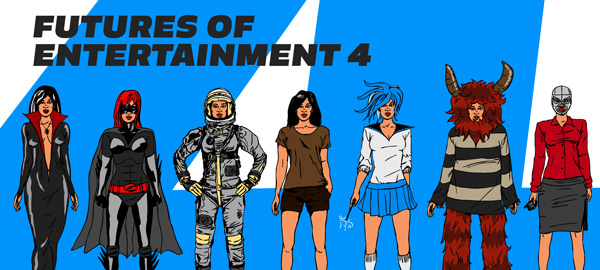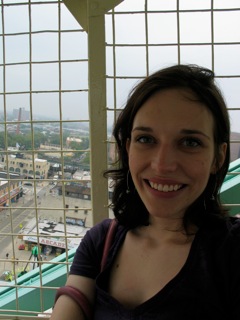| |
|||||||||
Follow the BlogDon't forget – you can always post, read, and carry out online conversations with the C3 team at our blog. CommentHajimemashite -- An Introduction by Alex Leavitt
My name is Alex Leavitt, and I am a researcher with the Convergence Culture Consortium. This past May (2009), I graduated from Boston University with a degree in English Literature & Language and Japanese Literature & Language, with a focus on literary theory and comparative literature. One semester prior, I was immersed in the foreign but vibrant culture of Kyoto, Japan, studying there through the Kyoto Consortium for Japanese Studies. Come December, I had finalized my application to the masters program in Comparative Media Studies; however, two days later, I discovered that the program had frozen admissions for the next academic year. But after a woeful and worrying summer, I must enthusiastically thank both Joshua Green and Daniel Pereira -- as well as Henry Jenkins, who originally suggested contacting the Consortium -- for enlisting me with the C3 team. I suppose that researching for the Consortium comes naturally. I grew up with the Nintendo Gameboy, Saturday morning cartoons, and Neopets.com; I was trained in middle school as a professional singer, musician, and music theorist at the Boston Archdiocesan Choir School in Harvard Square; and I have also worked as a research assistant on the Digital Natives project at the Berkman Center for Internet & Society at Harvard Law School. And, although my interest in Japan blossomed out of an obsession with origami in primary school, I have been heavily immersed in Japanese popular culture -- in particular, animation (anime) and comics (manga) -- so much that for the past few years I have traveled around the States giving talks at fan conventions, such as Anime Boston, Anime Expo (Los Angeles), and Otakon (Baltimore). Of course, I have also continuously been fascinated with the Internet. I grew up alongside its popular form, with the early days of AOL Instant Messenger, Hamster Dance, and Geocities.com. In essence, I am the epitome of who Prof. Jenkins likes to avoid calling digital natives. But I live and breath online communication and subculture, and it's common to spend more time online during the day than sleep at night. After meeting Tim Hwang through the Boston-area Students for Free Culture collaboration and getting involved with the ROFLcon team, I have recently been working and publishing with Tim and a team of researchers for the Web Ecology Project, where we analyze the flow of communication, community, and culture across social networks, dynamic platforms, and other online spaces. So, what am I doing here? Well, I would explain, but I have too many interests that intersect with the Consortium's research! Derived from my extracurricular interests, I'm aiming to study fandom in a new light, from the perspective of the audience: How is the concept of an audience redefined through its ever-changing practices on- and offline? Whether this research constitutes fans of anime or fans of the Olympics, we'll see in a few months. But I'm intrigued also to explore the intersection of fandom and one of C3's primary concepts, transmedia: How does transmedia affect a viewer's interpretation of a text? Finally, I would like to pursue the aesthetics of the transmedia concept -- transmedia storytelling, adaptation, franchise, and branding -- in relation to the physical structures of the media landscape. Does the combination of BitTorrent, online streaming, and fansubbing with television rips, live streaming, and HD standards affect how an audience absorbs a work, especially when some of these elements are intentional (eg., levels of quality, cultivated by producers) while others are unintentional (P2P sharing, unexpected by these same producers). I am very excited to be part of the Convergence Culture Consortium's team this year. To take up Sam Ford's mantle, I will be representing the primary voice on the C3 blog throughout the academic year, while I help organize this year's vigorous Futures of Entertainment 4 conference. Certainly I am looking forward to a personal sort of cultural immersion in the relationships fostered by the Consortium; hopefully I will meet many of you IRL during our events. Until then, yoroshiku (it's good to meet you)! Alex Leavitt is a researcher with the Convergence Culture Consortium. His primary research interests include the intersection of fandom & transmedia, Japanese animation & manga, and Internet (sub)cultures. In addition to the C3 blog, Alex writes at the Department of Alchemy and you can follow him on Twitter (@alexleavitt). He can be contacted at aleavitt@mit.edu.
Closing NoteFutures of Entertainment 4: Transmedia, Activism and Uncertain Business
We are deep in the planning stages for this year's Futures of Entertainment conference. This is the fourth time we've held this event, and the line-up and topics we have for this year's event promise to make Futures of Entertainment 4 one of the best in the series. For those of you who have never attended FoE before, the conference draws industry and academic speakers together with researchers from across the Consortium, providing a unique opportunity to participate in dynamic discussions about the future entertainment and media landscape. The event is organized around a "talk-show" style model, with panelists participating in moderated discussions about key issues affecting the future of the culture and creative industries; Futures of Entertainment 4 once again brings clever thinkers from both industry and the academy together for long conversations. Over the last three years this has produced deep, thorough treatments of issues ranging from the ethics of social media, effective strategies for participating in virtual worlds, the future of media metrics and measurement, and the challenges of building compelling transmedia experiences.  This year's conference will feature an entire day dedicated to interrogating some of the issues around the creative and business practices behind transmedia projects. Looking at the evolving business challenges of creating narratives, programs and campaigns that stretch across multiple platforms, Futures of Entertainment 4 will engage with questions around managing, producing, financing and positioning transmedia efforts, and how to identify the value created from transmedia projects. The event will look at some of the creative challenges that emerge from managing every larger franchises and which come from developing content for multiple mediums. Finally, day one of the conference will ask some serious questions about the future sustainability -- both from a creative and a business perspective -- of transmedia events. The second day of the event will feature panels on topics including contemporary media business models, aligning new audiences with contemporary research practice and the blurring of distinctions between communication mediums. While still staying true to the desire to privilege conversations over presentations, this year we are altering the format a little to encourage even deeper engagement with the issues at hand. In particular, two of the panels on the first day will revolve around a case-study format. The first panel of the event which looks at the creative challenges of producing transmedia narratives, will draw together speakers from production, creative design, scholarly and fan backgrounds to consider the task of transforming a classic narrative into a transmedia property. The panel immediately after this will bring together a rang of players each working in some way on the 'Purefold' project -- a project headed by the Scott Brothers (Ridley and Tony) that considers the key question at the heart of Bladerunner: "What does it mean to be human?" Included on this panel is David Bausola, co-founder of Ag8, the company behind the project. Confirmed speakers for this year's event include:
The first day concludes with a panel that looks at the potential of transmedia beyond entertainment and business. Titled Transmedia for Social Change, this panel asks "What are the potentials for transmedia to be used to affect social change? What parallels can we draw between the activities fan communities and other sites of collective activity?" This panel will consider the cross-over between the forms of collective activity that mark participation in transmedia narratives and other forms of collective activities that harness entertainment media for social good. Fan communities are increasingly aware of their power as social networks. With the ability to mobilize (often) large and passionate groups of people quickly in response to actions that threaten their values and practices, fan communities constitute collective bargaining units acting on the behalf of consumers. These communities may deploy this power to try to protect a favorite program from cancellation (thus working hand and hand with the interests of producers); they may deploy it to challenge a decision they feel hurts the integrity of the franchise (thus pushing back against a producer's perceived interests); or to resist cease and desist letters which threaten their activities. How do buy-cotts, the tactical deployment of consumption that has emerged as a key strategies for fans to have their voices heard, resemble other forms of consumer activism? Full conference details are available at the Futures of Entertainment site, including details on all seven of the panels we're putting together (the most we've ever had). The conference runs Friday and Saturday, November 20 and 21 on the MIT campus in Cambridge. Registration is complimentary for members of the consortium. As one of two annual events we hold, FoE is a great opportunity to bring the various members of the Consortium together to meet each other and foster communication across the network. With a keynote from Professor Henry Jenkins and a dynamic list of speakers from both industry and scholarly fields (and more to be announced), this is an event not to be missed! Joshua Green is a Postdoctoral Research Fellow in the Comparative Media Studies Program at MIT and Research Manager of the Convergence Culture Consortium. His research interests include online video, the changing structure of television networks, and evolving audience practices. His first book, YouTube: Online Video and Participatory Culture, is the first large-scale content analysis of YouTube's "most popular" videos, tracing connections between the site's architecture, the genre and themes of YouTube videos, and the nature of participatory culture. It is available from Polity Press.
|
This issue of the C3 Weekly Update compiled and edited by Joshua Green (jbgreen@mit.edu) for the Convergence Culture Consortium.
PRIVACY
You are receiving this update as a member of MIT C3. To subscribe or unsubscribe, send a request to dpereira@mit.edu.
We are committed to preserving your privacy. Your email address and any other contact details are only used for communication pertaining to C3 business and to maintain our records. The information will not be used for any commercial or philanthropic purpose not directly connected with or supported by MIT without your consent. Any changes to our policy will be posted here in the future. Any information collected prior to the changes will not be subject to the new policy without your consent. The information will remain subject to the policy at the time it was provided to us. Once the change in policy is posted, any new information that you provide and/or information associated with new orders will be subject to the new policy.
COPYRIGHT
This newsletter is provided as internal communication for C3 employees and graduate students, consulting researchers, and employees of C3's corporate partners. This e-mail publication is not to be shared with parties that do not have affiliation with the Consortium, in either electronic or printed form, without the permission of the Consortium's management.
The MIT C3 Weekly Update is Copyright ® 2009 by the MIT Convergence Culture Consortium. All rights reserved.
DISCLAIMER
The statements and opinions expressed in the C3 newsletter are those of the authors, individuals and/or contributors, and are not necessarily those of CMS or C3, its faculty or consortium members.
The MIT C3 Weekly Update is Copyright ® 2009 by the MIT Convergence Culture Consortium. All rights reserved.
